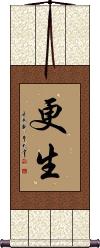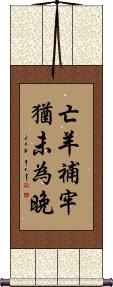Many custom options...
And formats...

Anew in Chinese / Japanese...
Buy an Anew calligraphy wall scroll here!
Personalize your custom “Anew” project by clicking the button next to your favorite “Anew” title below...
Rehabilitation / Rebirth
This is a Chinese, Korean and Japanese word that means rebirth or resurrection.
Other definitions include reinvigorated, rejuvenated, a new lease of life, rehabilitation, remaking one's life, starting life anew, regeneration, reorganization, rebuilding, recovery, restoration, remaking, coming back to life, revival, or resuscitation.
Better Late Than Never
It's Never Too Late Too Mend
Long ago in what is now China, there were many kingdoms throughout the land. This time period is known as “The Warring States Period” by historians because these kingdoms often did not get along with each other.
Sometime around 279 B.C. the Kingdom of Chu was a large but not particularly powerful kingdom. Part of the reason it lacked power was the fact that the King was surrounded by “yes men” who told him only what he wanted to hear. Many of the King's court officials were corrupt and incompetent which did not help the situation.
The King was not blameless himself, as he started spending much of his time being entertained by his many concubines.
One of the King's ministers, Zhuang Xin, saw problems on the horizon for the Kingdom, and warned the King, “Your Majesty, you are surrounded by people who tell you what you want to hear. They tell you things to make you happy and cause you to ignore important state affairs. If this is allowed to continue, the Kingdom of Chu will surely perish, and fall into ruins.”
This enraged the King who scolded Zhuang Xin for insulting the country and accused him of trying to create resentment among the people. Zhuang Xin explained, “I dare not curse the Kingdom of Chu but I feel that we face great danger in the future because of the current situation.” The King was simply not impressed with Zhuang Xin's words.
Seeing the King's displeasure with him and the King's fondness for his court of corrupt officials, Zhuang Xin asked permission from the King that he may take leave of the Kingdom of Chu, and travel to the State of Zhao to live. The King agreed, and Zhuang Xin left the Kingdom of Chu, perhaps forever.
Five months later, troops from the neighboring Kingdom of Qin invaded Chu, taking a huge tract of land. The King of Chu went into exile, and it appeared that soon, the Kingdom of Chu would no longer exist.
The King of Chu remembered the words of Zhuang Xin and sent some of his men to find him. Immediately, Zhuang Xin returned to meet the King. The first question asked by the King was “What can I do now?”
Zhuang Xin told the King this story:
A shepherd woke one morning to find a sheep missing. Looking at the pen saw a hole in the fence where a wolf had come through to steal one of his sheep. His friends told him that he had best fix the hole at once. But the Shepherd thought since the sheep is already gone, there is no use fixing the hole.
The next morning, another sheep was missing. And the Shepherd realized that he must mend the fence at once. Zhuang Xin then went on to make suggestions about what could be done to reclaim the land lost to the Kingdom of Qin, and reclaim the former glory and integrity of the Kingdom of Chu.
The Chinese idiom shown above came from this reply from Zhuang Xin to the King of Chu almost 2,300 years ago.
It translates roughly into English as...
“Even if you have lost some sheep, it's never too late to mend the fence.”
This proverb, 亡羊补牢犹未为晚, is often used in modern China when suggesting in a hopeful way that someone change their ways, or fix something in their life. It might be used to suggest fixing a marriage, quitting smoking, or getting back on track after taking an unfortunate path in life among other things one might fix in their life.
I suppose in the same way that we might say, “Today is the first day of the rest of your life” in our western cultures to suggest that you can always start anew.
Note: This does have Korean pronunciation but is not a well-known proverb in Korean (only Koreans familiar with ancient Chinese history would know it). Best if your audience is Chinese.
These search terms might be related to Anew:
Even the 100-Foot Bamboo Can Grow One More Foot
Not the results for anew that you were looking for?
Below are some entries from our dictionary that may match your anew search...
| Characters If shown, 2nd row is Simp. Chinese |
Pronunciation Romanization |
Simple Dictionary Definition |
更生 see styles |
gēng shēng geng1 sheng1 keng sheng tsugio つぎお |
More info & calligraphy: Rehabilitation / Rebirth(noun/participle) (1) rehabilitation; remaking one's life; starting life anew; (noun/participle) (2) rebirth; regeneration; reorganization; rebuilding; recovery; restoration; remaking; (noun/participle) (3) coming back to life; revival; resuscitation; (given name) Tsugio rebirth |
今更 see styles |
imasara いまさら |
(adverb) (1) now (after such a long time); at this late hour (i.e. it is too late for something); at this point of time; (2) afresh; anew; again |
再論 see styles |
sairon さいろん |
(noun, transitive verb) rediscussion; debating anew |
從頭 从头 see styles |
cóng tóu cong2 tou2 ts`ung t`ou tsung tou |
anew; from the start |
新編 新编 see styles |
xīn biān xin1 bian1 hsin pien shinpen しんぺん |
to compile anew; new (version); newly set up (part of an organization) new edition |
新製 see styles |
shinsei / shinse しんせい |
(noun, transitive verb) (1) producing anew; (2) newly manufactured item |
自新 see styles |
zì xīn zi4 xin1 tzu hsin |
to reform oneself; to mend one's ways and start life anew |
船出 see styles |
funade ふなで |
(noun/participle) (1) setting sail; putting out to sea; (noun/participle) (2) (idiom) starting anew; embarking on something new; (surname) Funade |
門出 see styles |
monde もんで |
(noun/participle) (1) leaving one's own house (e.g. when going to war); departure; setting out; (2) starting a new life; starting life anew; (surname) Monde |
首途 see styles |
shuto しゅと kadode かどで |
(noun/participle) (1) leaving one's own house (e.g. when going to war); departure; setting out; (2) starting a new life; starting life anew |
今さら see styles |
imasara いまさら |
(adverb) (1) now (after such a long time); at this late hour (i.e. it is too late for something); at this point of time; (2) afresh; anew; again |
再創造 see styles |
saisouzou / saisozo さいそうぞう |
(noun, transitive verb) creating anew; recreation; re-creation |
再認識 see styles |
saininshiki さいにんしき |
(noun/participle) recognizing anew; seeing something in a new light |
始まる see styles |
hajimaru はじまる |
(v5r,vi) (1) to begin; to start; to commence; (v5r,vi) (2) to happen (again); to begin (anew); (v5r,vi) (3) to date (from); to originate (in) |
改めて see styles |
aratamete あらためて |
(adverb) (1) another time; again; over again; once again; anew; (2) formally; especially; intentionally; deliberately |
新しく see styles |
atarashiku あたらしく |
(adverb) newly; new; anew |
新建ち see styles |
shindachi しんだち |
(1) newly rebuilt house; (noun or participle which takes the aux. verb suru) (2) to build a house anew |
事改めて see styles |
kotoaratamete ことあらためて |
(expression) anew |
事新しく see styles |
kotoatarashiku ことあたらしく |
(adverb) anew; again; specially; formally |
仕替える see styles |
shikaeru しかえる |
(transitive verb) to do over; to start anew |
付替える see styles |
tsukekaeru つけかえる |
(transitive verb) to renew; to replace; to change for; to attach anew |
新ためて see styles |
aratamete あらためて |
(irregular kanji usage) (adverb) (1) another time; again; over again; once again; anew; (2) formally; especially; intentionally; deliberately |
殻を破る see styles |
karaoyaburu からをやぶる |
(exp,v5r) (idiom) to break up and start anew; to break out of one's shell; to make a fresh start; to go outside oneself |
買い直す see styles |
kainaosu かいなおす |
(transitive verb) to buy again; to buy anew |
今更ながら see styles |
imasaranagara いまさらながら |
(expression) (1) although at this late hour; now, although it is too late; (2) afresh; anew; again |
付け換える see styles |
tsukekaeru つけかえる |
(transitive verb) to renew; to replace; to change for; to attach anew |
付け替える see styles |
tsukekaeru つけかえる |
(transitive verb) to renew; to replace; to change for; to attach anew |
白紙に戻す see styles |
hakushinimodosu はくしにもどす |
(exp,v5s) to wipe the slate clean; to start anew |
白紙に返す see styles |
hakushinikaesu はくしにかえす |
(exp,v5s) (See 白紙に戻す) to wipe the slate clean; to start anew |
買いなおす see styles |
kainaosu かいなおす |
(transitive verb) to buy again; to buy anew |
Click here for more anew results from our dictionary
The following table may be helpful for those studying Chinese or Japanese...
| Title | Characters | Romaji (Romanized Japanese) | Various forms of Romanized Chinese | |
| Rehabilitation Rebirth | 更生 | kousei / kose kosei / kose | gēng shēng geng1 sheng1 geng sheng gengsheng | keng sheng kengsheng |
| Better Late Than Never | 亡羊補牢猶未為晚 亡羊补牢犹未为晚 | wáng yáng bǔ láo yóu wèi wéi wǎn wang2 yang2 bu3 lao2 you2 wei4 wei2 wan3 wang yang bu lao you wei wei wan | wang yang pu lao yu wei wei wan wangyangpulaoyuweiweiwan |
|
| In some entries above you will see that characters have different versions above and below a line. In these cases, the characters above the line are Traditional Chinese, while the ones below are Simplified Chinese. | ||||
Successful Chinese Character and Japanese Kanji calligraphy searches within the last few hours...





